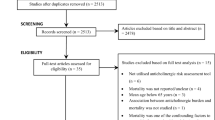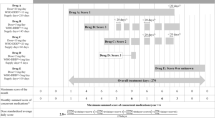Abstract
Purpose
The purpose of this study is to investigate whether there is an association between anticholinergic burden and mortality or rehospitalization in older adults discharged from hospital.
Methods
Prospective multicenter cohort study carried out with patients aged 65 and older discharged from seven acute care hospitals. The primary outcomes of the study were rehospitalization and mortality within 1 year after discharge. The study population was classified in three groups according to the anticholinergic exposure measured by the Anticholinergic Risk Scale (ARS) and Durán’s list at the time of hospital discharge: without risk (ARS/Durán = 0), low risk (ARS/Durán = 1), and high risk (ARS/Durán ≥ 2). Predictors of hospitalizations and mortality were examined using regression models adjusting for important covariates.
Results
The mean age of the 921 participants was 81.2 years (SD = 7.4 years). Prevalence of exposure to medications with anticholinergic activity ranged from 19.6% with ARS to 32.1% with Durán’s list. During the follow-up period, 30.4% of participants were hospitalized and 19.4% died. Multivariate regression analysis showed that low anticholinergic burden quantified according to Durán’s list was significantly associated with all-cause mortality (OR 1.69, 95% CI 1.02–2.82). This association was not present after adjustment when using ARS. No statistically significant association was found between anticholinergic burden and hospitalizations.
Conclusions
Taking medications with anticholinergic activity is associated with greater risk of mortality in older adults discharged from acute care hospitals. Strategies to reduce anticholinergic burden in vulnerable elders could be useful to improve health outcomes. Further research is required to assess the association between anticholinergic burden and hospitalizations in older patients.
Similar content being viewed by others
References
Vetrano DL, La Carpia D, Grande G, Casucci P, Bacelli T, Bernabei R et al (2016) Anticholinergic medication burden and 5-year risk of hospitalization and death in nursing home elderly residents with coronary artery disease. J Am Med Dir Assoc 17:1056–1059
de Leon J (2011) Paying attention to pharmacokinetic and pharmacodynamic mechanisms to progress in the area of anticholinergic use in geriatric patients. Curr Drug Metab 12:635–646
Bostock CV, Soiza RL, Mangoni AA (2010) Association between prescribing of antimuscarinic drugs and antimuscarinic adverse effects in older people. Expert Rev Clin Pharmacol 3:441–452
Chew DP, Anderson FA, Avezum A, Eagle KA, FitzGerald G, Gore JM et al (2010) Six-month survival benefits associated with clinical guideline recommendations in acute coronary syndromes. Heart 96:1201–1206
Durán CE, Azermai M, Vander Stichele RH (2013) Systematic review of anticholinergic risk scales in older adults. Eur J Clin Pharmacol 69:1485–1496
Tune LE (2001) Anticholinergic effects of medication in elderly patients. J Clin Psychiatry 62(Suppl 21):11–14
Villalba-Moreno AM, Alfaro-Lara ER, Perez-Guerrero MC, Nieto-Martin MD, Santos-Ramos B (2016) Systematic review on the use of anticholinergic scales in poly pathological patients. Arch Gerontol Geriatr 62:1–8
Rudolph JL, Salow MJ, Angelini MC, McGlinchey RE (2008) The anticholinergic risk scale and anticholinergic adverse effects in older persons. Arch Intern Med 168:508–513
Pasina L, Djade CD, Lucca U, Nobili A, Tettamanti M, Franchi C et al (2013) Association of anticholinergic burden with cognitive and functional status in a cohort of hospitalized elderly: comparison of the anticholinergic cognitive burden scale and anticholinergic risk scale. Drugs Aging 30:103–112
Fox C, Richardson K, Maidment ID, Savva GM, Matthews FE, Smithard D et al (2011) Anticholinergic medication use and cognitive impairment in the older population: the medical research council cognitive function and ageing study. J Am Geriatr Soc 59:1477–1483
Carriere I, Fourrier-Reglat A, Dartigues JF, Rouaud O, Pasquier F, Ritchie K et al (2009) Drugs with anticholinergic properties, cognitive decline, and dementia in an elderly general population: the 3-city study. Arch Intern Med 169:1317–1324
Wilson NM, Hilmer SN, March LM, Cameron ID, Lord SR, Seibel MJ et al (2010) Associations between drug burden index and physical function in older people in residential aged care facilities. Age Ageing 39:503–507
Wilson NM, Hilmer SN, March LM, Cameron ID, Lord SR, Seibel MJ et al (2011) Associations between drug burden index and falls in older people in residential aged care. J Am Geriatr Soc 59:875–880
Lampela P, Lavikainen P, Garcia-Horsman JA, Bell JS, Huupponen R, Hartikainen S (2013) Anticholinergic drug use, serum anticholinergic activity, and adverse drug events among older people: a population-based study. Drugs Aging 30:321–330
Dauphinot V, Faure R, Omrani S, Goutelle S, Bourguignon L, Krolak-Salmon P et al (2014) Exposure to anticholinergic and sedative drugs, risk of falls, and mortality: an elderly inpatient, multicenter cohort. J Clin Psychopharmacol 34:565–570
Wilson NM, Hilmer SN, March LM, Chen JS, Gnjidic D, Mason RS et al (2012) Associations between drug burden index and mortality in older people in residential aged care facilities. Drugs Aging 29:157–165
Kumpula EK, Bell JS, Soini H, Pitkala KH (2011) Anticholinergic drug use and mortality among residents of long-term care facilities: a prospective cohort study. J Clin Pharmacol 51:256–263
Luukkanen MJ, Uusvaara J, Laurila JV, Strandberg TE, Raivio MM, Tilvis RS et al (2011) Anticholinergic drugs and their effects on delirium and mortality in the elderly. Dement Geriatr Cogn Dis Extra 1:43–50
Lonnroos E, Gnjidic D, Hilmer SN, Bell JS, Kautiainen H, Sulkava R et al (2012) Drug burden index and hospitalization among community-dwelling older people. Drugs Aging 29:395–404
Uusvaara J, Pitkala KH, Kautiainen H, Tilvis RS, Strandberg TE (2011) Association of anticholinergic drugs with hospitalization and mortality among older cardiovascular patients: a prospective study. Drugs Aging 28:131–138
Salahudeen MS, Nishtala PS (2016) Examination and estimation of anticholinergic burden: current trends and implications for future research. Drugs Aging 33:305–313
Fusco D, Lattanzio F, Tosato M, Corsonello A, Cherubini A, Volpato S et al (2009) Development of CRIteria to assess appropriate Medication use among Elderly complex patients (CRIME) project: rationale and methodology. Drugs Aging 26(Suppl 1):3–13
Tosato M, Settanni S, Antocicco M, Battaglia M, Corsonello A, Ruggiero C et al (2013) Pattern of medication use among older inpatients in seven hospitals in Italy: results from the CRiteria to assess Appropriate Medication use among Elderly complex patients (CRIME) project. Curr Drug Saf 8:98–103
Onder G, Pedone C, Landi F, Cesari M, Della Vedova C, Bernabei R et al (2002) Adverse drug reactions as cause of hospital admissions: results from the Italian Group of Pharmacoepidemiology in the Elderly (GIFA). J Am Geriatr Soc 50:1962–1968
Folstein MF, Folstein SE, McHugh PR (1975) “Mini-mental state”. A practical method for grading the cognitive state of patients for the clinician. J Psychiatr Res 12:189–198
Katz S, Ford AB, Moskowitz RW, Jackson BA, Jaffe MW (1963) Studies of illness in the aged. The index of Adl: a standardized measure of biological and psychosocial function. JAMA 185:914–919
Sganga F, Landi F, Ruggiero C, Corsonello A, Vetrano DL, Lattanzio F et al (2015) Polypharmacy and health outcomes among older adults discharged from hospital: results from the CRIME study. Geriatr Gerontol Int 15:141–146
WHO Collaborating Center for Drugs Statistics Methodology. International language for drug utilization research 2016. http://www.whocc.no/. Accesed 24 January 2017
Salahudeen MS, Duffull SB, Nishtala PS (2015) Anticholinergic burden quantified by anticholinergic risk scales and adverse outcomes in older people: a systematic review. BMC Geriatr 15:31
Mayer T, Haefeli WE, Seidling HM (2015) Different methods, different results—how do available methods link a patient's anticholinergic load with adverse outcomes? Eur J Clin Pharmacol 71:1299–1314
Cardwell K, Hughes CM, Ryan C (2015) The association between anticholinergic medication burden and health related outcomes in the ‘Oldest Old’: a systematic review of the literature. Drugs Aging 32:835–848
Myint PK, Fox C, Kwok CS, Luben RN, Wareham NJ, Khaw KT (2015) Total anticholinergic burden and risk of mortality and cardiovascular disease over 10 years in 21,636 middle-aged and older men and women of EPIC-Norfolk prospective population study. Age Ageing 44:219–225
Panula J, Puustinen J, Jaatinen P, Vahlberg T, Aarnio P, Kivela SL (2009) Effects of potent anticholinergics, sedatives and antipsychotics on postoperative mortality in elderly patients with hip fracture: a retrospective, population-based study. Drugs Aging 26:963–971
Salahudeen MS, Hilmer SN, Nishtala PS (2015) Comparison of anticholinergic risk scales and associations with adverse health outcomes in older people. J Am Geriatr Soc 63:85–90
Dispennette R, Elliott D, Nguyen L, Richmond R (2014) Drug burden index score and anticholinergic risk scale as predictors of readmission to the hospital. Consult Pharm 29:158–168
Huang K-H, Chan Y-F, Shih H-C, Lee C-Y (2012) Relationship between potentially inappropriate anticholinergic drugs (PIADs) and adverse outcomes among elderly patients in Taiwan. J Food Drug Anal 20:930–937
Mayer T, Meid AD, Saum KU, Brenner H, Schottker B, Seidling HM et al (2017) Comparison of nine instruments to calculate anticholinergic load in a large cohort of older outpatients: association with cognitive and functional decline, falls, and use of laxatives. Am J Geriatr Psychiatry 25:531–540
Lertxundi U, Isla A, Solinis MA, Domingo-Echaburu S, Hernandez R, Peral-Aguirregoitia J et al (2015) Anticholinergic burden in Parkinson’s disease inpatients. Eur J Clin Pharmacol 71:1271–1277
Montastruc F, Rouanet S, Gardette V, Rousseau V, Bagheri H, Montastruc JL (2015) Atropinic burden of prescriptions forms in patients with Alzheimer disease: a cross-sectional study in a French PharmacoVigilance Database. Eur J Clin Pharmacol 71:891–895
Lowry E, Woodman RJ, Soiza RL, Mangoni AA (2011) Associations between the anticholinergic risk scale score and physical function: potential implications for adverse outcomes in older hospitalized patients. J Am Med Dir Assoc 12:565–572
Lowry E, Woodman RJ, Soiza RL, Hilmer SN, Mangoni AA (2012) Drug burden index, physical function, and adverse outcomes in older hospitalized patients. J Clin Pharmacol 52:1584–1591
Mangoni AA, van Munster BC, Woodman RJ, de Rooij SE (2013) Measures of anticholinergic drug exposure, serum anticholinergic activity, and all-cause postdischarge mortality in older hospitalized patients with hip fractures. Am J Geriatr Psychiatry 21:785–793
Kidd AC, Musonda P, Soiza RL, Butchart C, Lunt CJ, Pai Y et al (2014) The relationship between total anticholinergic burden (ACB) and early in-patient hospital mortality and length of stay in the oldest old aged 90 years and over admitted with an acute illness. Arch Gerontol Geriatr 59:155–161
Nishtala PS, Narayan SW, Wang T, Hilmer SN (2014) Associations of drug burden index with falls, general practitioner visits, and mortality in older people. Pharmacoepidemiol Drug Saf 23:753–758
Acknowledgements
The CRIME project was funded by a grant of the Italian Ministry of Labor, Health and Social Policy (Bando Giovani Ricercatori 2007, convenzione n. 4). The author Marta Gutiérrez-Valencia received the grant of the Specialized Healthcare Posttraining Program from the Complejo Hospitalario de Navarra, Pamplona, Spain. The funding sources had no involvement in the design, collection, analysis and interpretation of data, in the writing of the report or in the decision to submit the article for publication.
Author information
Authors and Affiliations
Contributions
MGV, NMV and SLA have contributed to conception and design, analysis and interpretation of data, drafting the article and final approval of the version to be published. DLV, AC, FL and GO have contributed to conception and design, acquisition, interpretation of data, revising the text and final approval of the version to be published.
Corresponding author
Ethics declarations
All procedures performed in studies involving human participants were in accordance with the ethical standards of the institution and/or national research committee and with the Helsinki declaration and its later amendments or comparable ethical standards. Informed consent was obtained from all individual participants included in the study.
Conflict of interest
The authors declare that they have no conflict of interest.
Electronic supplementary material
ESM 1
(PDF 39 kb).
Rights and permissions
About this article
Cite this article
Gutiérrez-Valencia, M., Martínez-Velilla, N., Vetrano, D.L. et al. Anticholinergic burden and health outcomes among older adults discharged from hospital: results from the CRIME study. Eur J Clin Pharmacol 73, 1467–1474 (2017). https://doi.org/10.1007/s00228-017-2312-5
Received:
Accepted:
Published:
Issue Date:
DOI: https://doi.org/10.1007/s00228-017-2312-5




